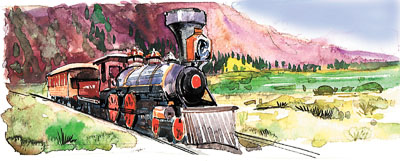Nevada State Railroad Museum brings past to life

Nevada’s State Railroad Museum in Carson City brings to life the colorful era of railroading that helped shape the Silver State. The railroads once knitted together the fabric of civilization covering settled places across vast distances in Nevada. The museum preserves and restores vintage locomotives, self-powered rail cars and varied rolling stock from 19th century railroads in Nevada, especially the Virginia and Truckee Railroad.
Better known as the V&T, the historic line built in 1869 served the mines of the fabulous Comstock Lode. It carried ore from the mountain boomtown to mills in the valley below near Carson City. After the V&T Railroad ceased operations in 1938, much of its equipment ended up in Hollywood, where filmmakers busily re-reated the Old West for enthralled movie-goers.
The museum purchased old pieces of railroad history from several movie companies. The equipment was often in poor condition from filmed wrecks or fires, as well as neglect. The railroad museum now houses 31 pieces of the V&T in its collection of 65 locomotives and other train components. The task of restoring the old equipment remains ongoing, much of it accomplished with volunteer efforts and monetary donations.
The museum facility off U.S. 395 on the southern edge of the state’s capital city occupies acreage large enough to display and operate trains. Visitors experience the thrill of rail journeys from yesteryear under steam or diesel power. The popular ride on a 1926 diesel-powered rail car tours the yards every half-hour each weekend. On many weekends and special occasions, crews fire up one of several restored steam locomotives to pull passenger trains.
Opened to visitors in 1980, the railroad museum stays open all year from 8:30 a.m. to 4:30 p.m., except for Thanksgiving, Christmas and New Year’s Day. Regular admission is $4. Seniors pay $3. Youngsters under 18 years of age enter free of charge. Rail car rides cost $4 for adults, $3 for seniors and $2 for youngsters age 6 to 11. Steam train fares are similar. Children under 6 ride free of charge on all excursions, but must be accompanied by an adult. For details, call the museum at (775) 687-6933 or look it up on the internet under Nevada Department of Cultural Affairs, Division of Museums and History.
For a fare of $25, two visitors at a time ride the steam trains with the engineer in the cab of one of the huge restored locomotives. Many who relish the excursion as adults realize the dreams they had as little kids watching the trains roll by. Kids waving at the men who drove the trains and often receiving a wave or a blast of the train’s horn or whistle used to be a part of the American landscape.
Be sure to visit the museum shop with its railroad themed books, toys and souvenirs. Indoor exhibits include changing displays different each time you visit. An absorbing exhibit several years in production features working models of 20th century Nevada railroads. The HO scale, 1/87th size trains, run through model mining camps, mountains and deserts typical of Nevada’s topography.
Developed from a private collection donated to the museum, the exhibit includes models of the Southern Pacific, Western Pacific and Union Pacific, as well as model trains from other collections. Tour the exhibit with a volunteer conductor, or start the trains yourself with a push of a button. Visitors can even call up trains from a specific decade in the last century.
On Aug. 16-17, the Nevada State Railroad Museum plans a special “steam-up” to help commemorate Carson City’s 150th birthday. A vintage 1888 steam locomotive will power train trips every 40 minutes that weekend.
Other Carson City Sesquicentennial events include a chili cook-off, craft fair, entertainment, a special medallion stamping at the Carson City Mint and cutting of the official birthday cake at the Carson City Nugget at 3 p.m. Saturday. Other upcoming railroad-related special events include the Virginia City-Carson City Railroad Festival on Aug. 8-9 and the Labor Day Steam-up with excursions at the museum Aug. 30, 31 and Sept. 1.
Margo Bartlett Pesek’s column appears on Sundays.